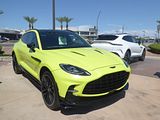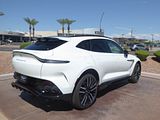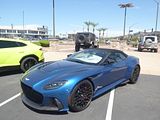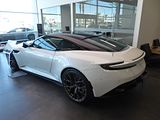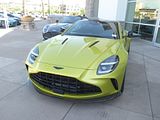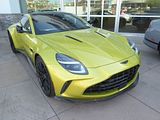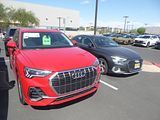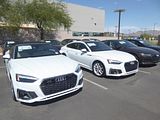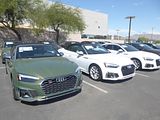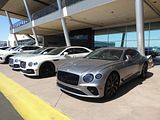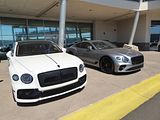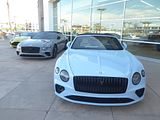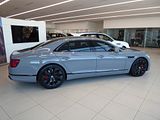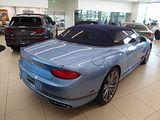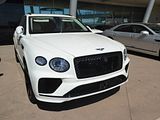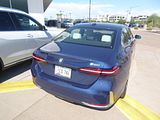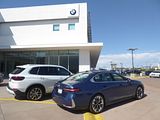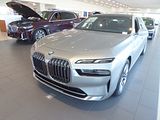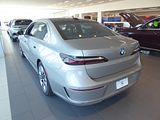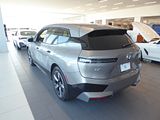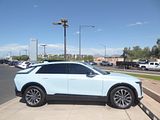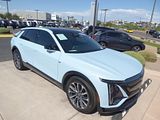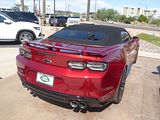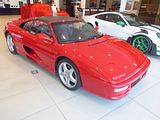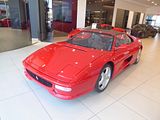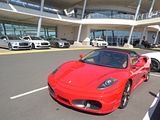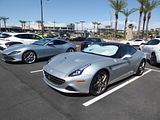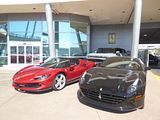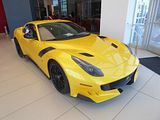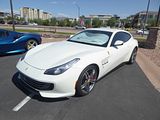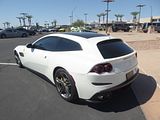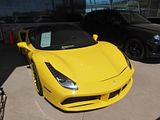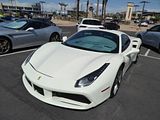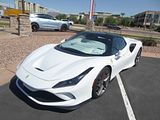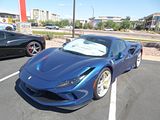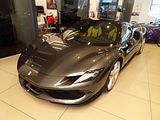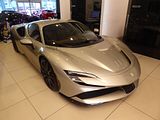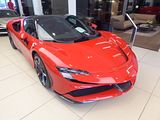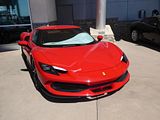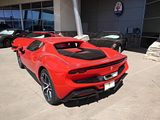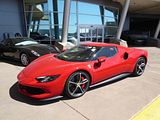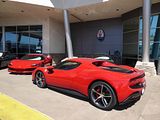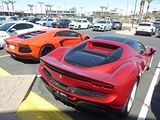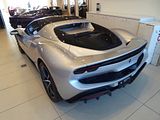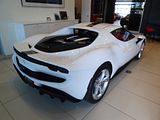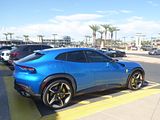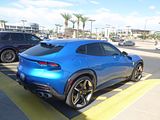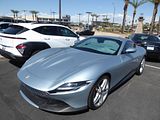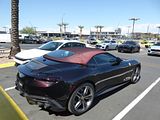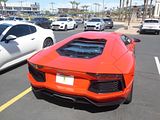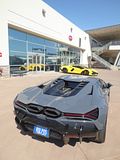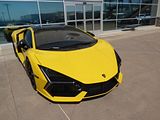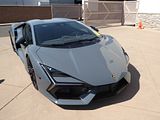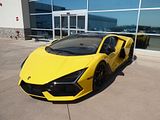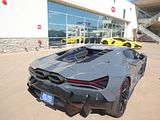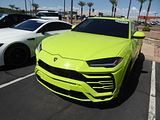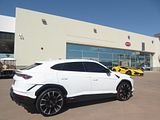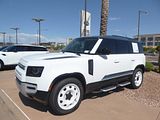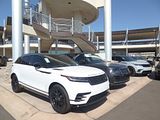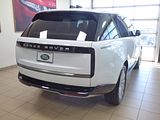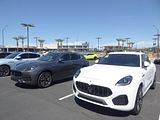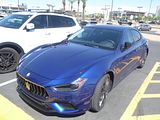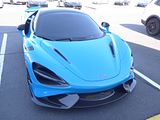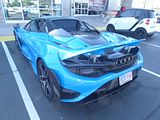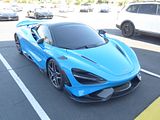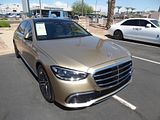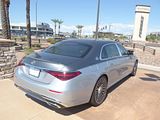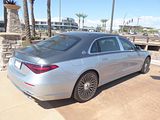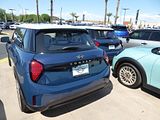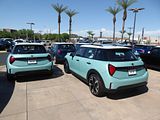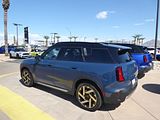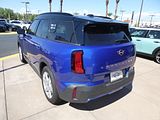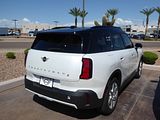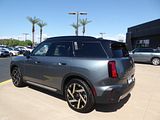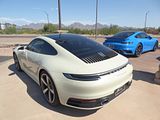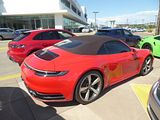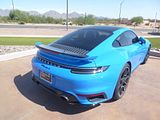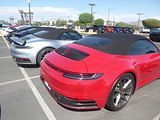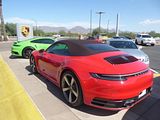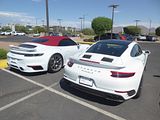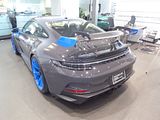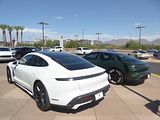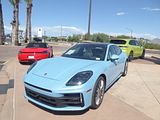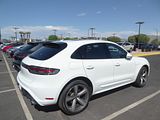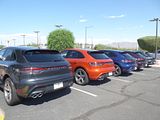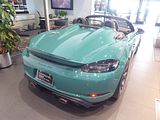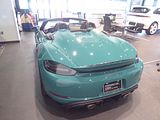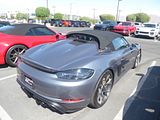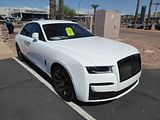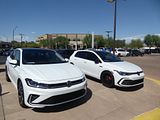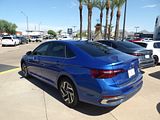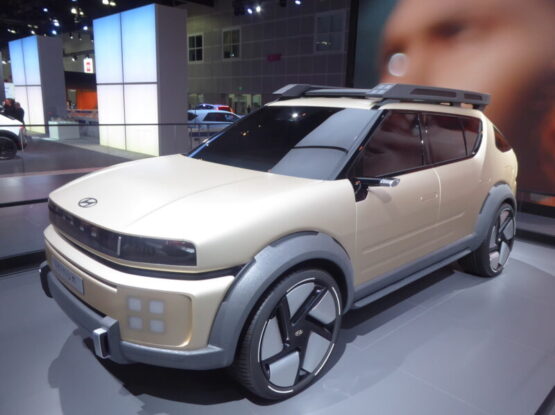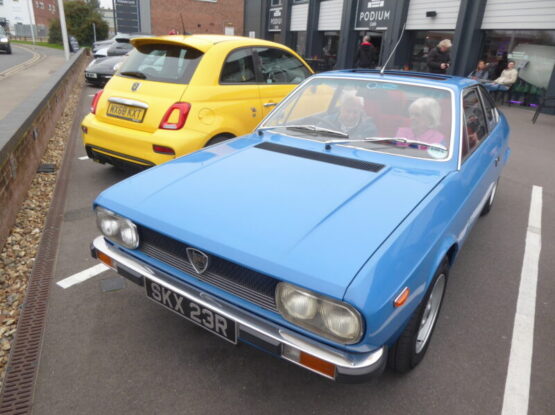Car showrooms tend be congregated together in US towns and cities, with a great long line of them often literally next door to each other. Most are large sites holding vast inventory, as American buyers expect to be able to walk in and drive out in a new car of the spec and colour of their choice in one trip, not something that generally happens in Europe at all, where buyers are usually prepared to wait for a factory order to come through to get the car of their dreams. With large dealer groups just common in the US as they are in the UK, holding multiple marque franchises, even where you get a site such as this one, all owned by the Penske Group, located just off the Scottsdale Road in the Greater Phoenix area, there’s quite an array of cars to see. In this case, they are all premium or very high end brands, too, reflecting almost the entirety of the non domestic luxury brands available to American buyers. The site is well known and is something of a tourist attraction, and the individual dealer staff do seem to welcome people such as me just dropping in for a look even though there is no chance of making a purchase, as they quickly find when they learn I live a few thousand miles away. I’ve been here on many occasions over the years and the staff are always happy to chat, if they are not busy, and generous in handing out bottles of ice cold water, which are always welcome. In 2021 and 2022, the showrooms were pretty empty and the massive parking lots out front and back were even more so, thanks to the chip supply shortages, but things were more nearly back to how they had been pre-Covid when I visited in 2023 and the same was true this time. Not quite as well stocked, perhaps, but with plenty of cars here. If you go round the back, there are large lines of pre-owned cars as well as a whole load of new ones, and there were a couple of rarities here which caught I was not perhaps expecting to see. Here then are the cars that caught my eye in the time wandering around outside and from inside the showrooms I entered, which was not quite all of them. It’s almost like a mini Auto Show in its own right!
ACURA
I will admit that this is a showroom I did not go in. Even walking past and pausing to take a photo seems always to get a particularly eager sales person coming over to ask if he can help. In recent years, the brand has recovered from the unfortunate styling phase that blighted the cars for a generation or two, and during that time, the emphasis has shifted much more heavily in favour of SUVs. So whilst Acura do have a couple of non-SUVs in the range, the TLX which is like a posh Accord and the well rated Integra which is based on the Civic, it is the MDX and RDX which dominate and those are the cars featured here.
ASTON MARTIN
The DBX is the strongest seller in the Aston Martin range in this part of America, not surprisingly, and so the dealer here always maintains good stock, with a long line of the model parked up outside in the sunshine.
The Aston Martin DBS Superleggera, also sold as the Aston Martin DBS, is a grand touring car produced from 2018 to 2024. In June 2018, Aston Martin unveiled the car as a replacement to the second-generation Vanquish. It is based on the DB11 V12, but featuring modifications that differentiate it from the DB11 lineage. The DBS name was previously used for a model built from 1967 to 1972 and for the DB9-based DBS between 2007 and 2012. In addition, the car also uses the Superleggera name which is a reference to Carrozzeria Touring Superleggera, who helped Aston Martin develop their lightest grand tourers in the 1960s and 1970s. In September 2024, Aston Martin announced the third-generation Vanquish as the successor of the DBS Superleggera. The front of the DBS features a new front bumper, with a larger centre grille compared to the DB11, for improved engine cooling, along with two air extractors on the sides to cool the brakes and two vents on the hood that aid in the engine cooling process. The 5.2-litre twin-turbocharged V12 engine, which is cast and manufactured at Grainger & Worrall in the United Kingdom before being shipped to the Aston Martin engine plant in Cologne for assembly, is rated at 725 PS at 6,500 rpm and 900 Nm (664 lb/ft) of torque from 1,800–5,000 rpm. In order to optimise the centre of gravity and weight distribution, the engine has been positioned as low and as far back in the chassis as possible. The DBS Superleggera features the new ZF 8HP95 transmission with a shorter final-drive ratio of 2.93:1, in contrast to the DB11’s 2.70:1. Chassis-wise, it also comes with torque vectoring and a mechanical limited slip differential for more focused track performance. The car also features many of the same aerodynamic features first seen on the DB11, including Aston Martin’s Aeroblade system, but refines aerodynamics with an F1-inspired double-diffuser that helps the car generate 397 lb (180 kg) of downforce – the highest figure ever for a series production Aston Martin. A new quad-pipe titanium exhaust system improves engine sound, while the usage of carbon fibre in major areas of the car lowers the weight down to 1,693 kg (3,732 lb). The DBS Superleggera can accelerate from 0–100 km/h (62 mph) in 3.4 seconds, and 0–161 km/h (100 mph) in 6.4 seconds. The car can also accelerate from 80–161 km/h (50–100 mph) in 4.2 seconds at fourth gear and can attain a top speed of 340 km/h (211 mph). Three driving modes are available: GT, Sport, and Sport Plus which adjust the car’s responsiveness. A Volante (convertible) model of the DBS was unveiled in April 2019. It has nearly identical performance and the same engine and transmission as the coupé but comes with an eight-layer soft top with eight colour options. For the first time on an Aston Martin automobile, the windshield surround is available in carbon fibre as well as the rear tonneau cover. There were a number of limited edition versions produced, too, in very small quantities.
Final Aston Martin of note was the recently revised Vantage model, supplies of which are just reaching the US a few months after sales started in Europe.
AUDI
Penske built a brand new and larger Audi showroom a few years ago and this is now standalone from the rest of the complex. There is ample space around it for vast numbers of new cars and that is what I saw there. Long lines of every Q model sold in the US (they do not get the Q2 but they get all the others) and also probably as many of the e-Tron GT here as I have ever seen in total elsewhere.
There were a number of the saloon models here, too. Americans do get them all, but with a more restricted range of engine options.
BENTLEY
The new generation of the Continental has yet to reach America, so the cars seen here were the outgoing version and there were plenty of them as well as the Bentayga.
BMW
I did go into the BMW showroom this time, and this is where I got the chance to look at the recently revealed fourth generation X3, deliveries of which seem to have arrived here before Europe gets them. Visually, what a horror. This really is like the much reviled XM shrunk down somewhat. It is awkward and blocky from every angle and the inside is festooned with features which someone probably thought were cool when they were signed off but which in reality are pretty pointless.
BMW’s styling has been the subject of much comment in the last few years and very little of has been positive. One look at the latest 5 and 7 series shows us why……… gone is the elegance of 25 years ago, these are big blocky slab-sided horrors which are hard to like visually.
And they are not the only culprits: look at the latest 4 Gran Coupe and compare it to its quite good looking predecessor. Of course, the i4 is basically the same car, so it is equally awkward. And then there is the iX. Familiarity has not made us like the looks any more even if dynamically it is apparently quite a decent car.
The X7 does not look like the vast thing it is here in the US, so you can see whay BMW felt the need to make it. Just don’t try to park one in Europe!
CADILLAC
This is the Lyriq, one of a series of all-electric Cadilac models which have appeared in the last couple of years and with the exception of the monster- sized Escalade, allof which have names that end in “..iq”. This one is what they call mid-sized, sitting between the Optiq and the huge and very costly Celestiq.
CHEVROLET
There were a couple of Chevrolet models parked up out front, the recently discontinued Camaro and the latest C8 generation Corvette.
FERRARI
There are always plenty of pre-owned Ferrari models here, either outside the showroom, or sometimes in it and that was the case this time, with quite an array of different cars from the past thirty years to look at.
Stung by the criticism of the 348, Ferrari undertook a comprehensive revision, creating the F355 model which they launched in May 1994. An evolution of the Ferrari 348, just about everything was changed, and improved. Design emphasis for the F355 was placed on significantly improved performance, but driveability across a wider range of speeds and in different environments such as low-speed city traffic was also addressed, as the Honda NS-X had proved that you could make a supercar that could be lived with every day. Apart from the displacement increase from 3.4 to 3.5 litres, the major difference between the V8 engine in the 348 and F355 was the introduction of a 5-valve cylinder head. This new head design allowed for better intake permeability and resulted in an engine that was considerably more powerful, producing 375 hp. The longitudinal 90° V8 engine was bored 2mm over the 348’s engine, resulting in the small increase in displacement. The F355 had a Motronic system controlling the electronic fuel injection and ignition systems, with a single spark plug per cylinder, resulting in an unusual 5 valves per cylinder configuration. This was reflected in the name, which did not follow the formula from the previous decades of engine capacity in litres followed by number of cylinders such as the 246 = 2.4 litres and 6 cylinders and the 308 of 3.0 litres and 8 cylinders. For the F355, Ferrari used engine capacity followed by the number of valves per cylinder (355 = 3.5 litres engine capacity and 5 valves per cylinder) to bring the performance advances introduced by a 5 valve per cylinder configuration into the forefront. 5. The frame was a steel monocoque with tubular steel rear sub-frame with front and rear suspensions using independent, unequal-length wishbones, coil springs over gas-filled telescopic shock absorbers with electronic control servos and anti-roll bars. The car allows selection between two damper settings, “Comfort” and “Sport”. Ferrari fitted all road-going F355 models with Pirelli tires, size 225/40ZR 18 in front and 265/40 ZR 18 in the rear. Although the F355 was equipped with power-assisted steering (intended to improve low-speed driveability relative to the outgoing 348), this could optionally be replaced with a manual steering rack setup by special order. Aerodynamic designs for the car included over 1,300 hours of wind tunnel analysis. The car incorporates a Nolder profile on the upper portion of the tail, and a fairing on the underbody that generates downforce when the car is at speed. These changes not only made the car faster but also much better to drive,m restoring Ferrari to the top of the tree among its rivals. At launch, two models were available: the coupe Berlinetta and the targa topped GTS, which was identical to the Berlinetta apart from the fact that the removable “targa-style” hard top roof could be stored behind the seats. The F355 would prove to be last in the series of mid-engined Ferraris with the Flying Buttress rear window, a lineage going back to the 1965 Dino 206 GT, unveiled at the Paris Auto Show. The Spider (convertible) version came later in the year. In 1997 the Formula One style paddle gear shift electrohydraulic manual transmission was introduced with the Ferrari 355 F1 adding £6,000 to the dealer asking price. This system promised faster gearchanges and allowed the driver to keep both hands on the steering wheel, It proved to be very popular and was the beginning of the end for the manual-transmission Ferrari. Ferrari produced 4,871 road-going Berlinetta models, of which 3,829 were 6-speed and 1,042 were F1 transmissions. The Spider proved to be the second-most popular F355 model, with a total production of 3,717 units, of which 2,664 were produced with the 6-speed transmission and another 1,053 produced with the F1 transmission. A total of 2,577 GTS models were produced, with 2,048 delivered with the 6-speed transmission and another 529 with the F1 transmission. This was the last GTS targa style model produced by Ferrari. This made a total production run of 11,273 units making the F355 the most-produced Ferrari at the time, though this sales record would be surpassed by the next generation 360 and later, the F430.
Effectively a mid-life update to the 360 Modena, the F430 debuted at the 2004 Paris Motor Show. Designed by Pininfarina, under the guidance of Frank Stephenson, the body styling of the F430 was revised from the 360 Modena, to improve its aerodynamic efficiency. Although the drag coefficient remained the same, downforce was greatly enhanced. Despite sharing the same basic Alcoa Aluminium chassis, roof line, doors and glass, the car looked significantly different from the 360. A great deal of Ferrari heritage was included in the exterior design. At the rear, the Enzo’s tail lights and interior vents were added. The car’s name was etched into the Testarossa-styled driver’s side mirror. The large oval openings in the front bumper are reminiscent of Ferrari racing models from the 60s, specifically the 156 “sharknose” Formula One car and 250 TR61 Le Mans cars of Phil Hill. Designed with soft-top-convertible. The F430 featured a 4.3 litre V8 petrol engine of the “Ferrari-Maserati” F136 family. This new power plant was a significant departure for Ferrari, as all previous Ferrari V8’s were descendants of the Dino racing program of the 1950s. This fifty-year development cycle came to an end with the entirely new unit. The engine’s output was 490 hp at 8500 rpm and 343 lb/ft of torque at 5250 rpm, 80% of which was available below 3500rpm. Despite a 20% increase in displacement, engine weight grew by only 4 kg and engine dimensions were decreased, for easier packaging. The connecting rods, pistons and crankshaft were all entirely new, while the four-valve cylinder head, valves and intake trumpets were copied directly from Formula 1 engines, for ideal volumetric efficiency. The F430 has a top speed in excess of 196 mph and could accelerate from 0 to 100 km/h in 3.9 seconds, 0.6 seconds quicker than the old model. The brakes on the F430 were designed in close cooperation with Brembo (who did the calipers and discs) and Bosch (who did the electronics package),resulting in a new cast-iron alloy for the discs. The new alloy includes molybdenum which has better heat dissipation performance. The F430 was also available with the optional Carbon fibre-reinforced Silicon Carbide (C/SiC) ceramic composite brake package. Ferrari claims the carbon ceramic brakes will not fade even after 300-360 laps at their test track. The F430 featured the E-Diff, a computer-controlled limited slip active differential which can vary the distribution of torque based on inputs such as steering angle and lateral acceleration. Other notable features include the first application of Ferrari’s manettino steering wheel-mounted control knob. Drivers can select from five different settings which modify the vehicle’s ESC system, “Skyhook” electronic suspension, transmission behaviour, throttle response, and E-Diff. The feature is similar to Land Rover’s “Terrain Response” system. The Ferrari F430 was also released with exclusive Goodyear Eagle F1 GSD3 EMT tyres, which have a V-shaped tread design, run-flat capability, and OneTRED technology. The F430 Spider, Ferrari’s 21st road going convertible, made its world premiere at the 2005 Geneva Motor Show. The car was designed by Pininfarina with aerodynamic simulation programs also used for Formula 1 cars. The roof panel automatically folds away inside a space above the engine bay. The conversion from a closed top to an open-air convertible is a two-stage folding-action. The interior of the Spider is identical to that of the coupé. Serving as the successor to the Challenge Stradale, the 430 Scuderia was unveiled by Michael Schumacher at the 2007 Frankfurt Auto Show. Aimed to compete with cars like the Porsche RS-models and the Lamborghini Gallardo Superleggera it was lighter by 100 kg/220 lb and more powerful (510 PS) than the standard F430. Increased power came from a revised intake, exhaust, and an ion-sensing knock-detection system that allows for a higher compression ratio. Thus the weight-to-power ratio was reduced from 2.96 kg/hp to 2.5 kg/hp. In addition to the weight saving measures, the Scuderia semi-automatic transmission gained improved “Superfast”, known as “Superfast2”, software for faster 60 millisecond shift-times. A new traction control system combined the F1-Trac traction and stability control with the E-Diff electronic differential. The Ferrari 430 Scuderia accelerates from 0-100 km/h in 3.6 seconds, with a top speed of 202 miles per hour. Ferrari claimed that around their test track, Fiorano Circuit, it matched the Ferrari Enzo, and the Ferrari F430’s successor, the Ferrari 458. To commemorate Ferrari’s 16th victory in the Formula 1 Constructor’s World Championship in 2008, Ferrari unveiled the Scuderia Spider 16M at World Finals in Mugello. It is effectively a convertible version of the 430 Scuderia. The engine produces 510 PS at 8500 rpm. The car has a dry weight of 1,340 kg, making it 80 kg lighter than the F430 Spider, at a curb weight of 1,440 kg (3,175 lb). The chassis was stiffened to cope with the extra performance available and the car featured many carbon fibre parts as standard. Specially lightened front and rear bumpers (compared to the 430 Scuderia) were a further sign of the efforts Ferrari was putting into this convertible track car for the road. Unique 5-spoke forged wheels were produced for the 16M’s launch and helped to considerably reduce unsprung weight with larger front brakes and callipers added for extra stopping power (also featured on 430 Scuderia). It accelerates from 0-100 km/h in 3.7 seconds, with a top speed of 315 km/h (196 mph). 499 vehicles were released beginning early 2009 and all were pre-sold to select clients.
The Ferrari California T (Type 149M) is an updated design of the California model featuring new sheetmetal and revised body features; a new interior, a revised chassis and a new turbocharged powertrain. First unveiled on the web on February 12, 2014, subsequently, the car debuted at the Geneva Motor Show. The T in the moniker stands for Turbo, a technology Ferrari last used on the F40 roadcar. The car utilizes a new 3,855 cc twin-turbocharged V8 engine that produces 560 PS (553 bhp) at 7,500 rpm and 755 Nm (557 lb/ft) at 4,750 rpm as well as a 7-speed dual clutch transmission with different gear ratios, a revised MagneRide adaptive suspension, as well as a new F1 Trac system. The car can accelerate from 0–100 km/h (0–62 mph) in 3.6 seconds and attain a top speed of 315 km/h (196 mph). The car also features a new front fascia that was influenced by the F12, a revised rear section and a revised interior. The revised rear end replaced the two sets of two vertically stacked exhaust pipes with four horizontally aligned pipes. Another improvement to the car is the reduction of emission pollution by 15% compared to its naturally aspirated predecessor. The car also utilises small turbo chargers and a variable boost management system to reduce turbo lag. It is also the first Ferrari road car debuting the new Apple CarPlay functionality into its built-in infotainment system – Apple confirmed at the launch of the Geneva Motor Show that Ferrari, Mercedes-Benz and Volvo would be among the first car manufacturers to bring CarPlay compatible models to the market. Similarly to the previous generation, a Handling Speciale (HS) package was made available for the California T, providing sportier handling at the expense of a stiffer ride. The Handling Speciale includes stiffer springs front and aft, retuned magnetorheological dampers, faster gear shifts when in Sport mode, a reprogrammed F1-Trac stability control, and a new sport exhaust system. Visually, the HS package-equipped cars are distinguished by a matte grey grille and rear diffuser, matte black diffuser fences and matte black exhaust tips. The California T Handling Speciale was unveiled at the March 2016 Geneva Motor Show. Through the Tailor Made programme, the California T was produced in several special editions and could also be customised to suit individual customers. For Ferrari’s 70th anniversary in 2017, this included 70 liveries inspired by the company’s iconic cars of the past such as the 250 GT Berlinetta SWB and Steve McQueen’s 1963 250 GT Berlinetta lusso. The California T Tailor Made liveries were unveiled at the March 2016 Geneva Motor Show and also shown at other subsequent motor shows such as the October 2016 Paris Motor Show. Production ceased in 2019 when the car was replaced by the Portofino.
The F12 TdF was unveiled in October 2015, as a faster, lighter and more powerful special edition of the regular F12 Berlinetta. The accompanying press releases informed us that the the car was created in homage to the legendary Tour de France road races, which it dominated in the 1950s and 1960s with the likes of the 1956 250 GT Berlinetta. However, the full Tour de France name cannot be used, as this is registered to the famous annual cycle race held in France, and even the might of Ferrari’s often belligerent and bullying legal department clearly had not managed to get past that obstacle. The F12 TdF, described by its maker as “the ultimate expression of the concept of an extreme road car that is equally at home on the track”, keeps the same 6.3-litre naturally aspirated V12 engine as the regular F12 Berlinetta, but power has been boosted from 730bhp to 770bhp at 8500rpm, while torque has increased from 509lb ft to 520lb ft at 6750rpm. Ferrari says 80% of the car’s torque is available from 2500rpm. By comparison, McLaren’s 675LT features a 3.8-litre twin-turbocharged V8 engine and produces 660bhp and 516lb ft – enough to give it a 0-62mph sprint time of 2.9 seconds. The older Ferrari 458 Speciale, meanwhile, made 597bhp from its 4.5-litre naturally aspirated V8. The car is capable of reaching 62mph in 2.9sec and has a top speed of more than 211mph. Official fuel consumption is rated at 18.3mpg, with CO2 emissions of 360g/km. Ferrari says it has has used various modifications derived from its F1 cars to boost the engine’s efficiency. The F12 TdF uses a new version of the firm’s dual-clutch automatic transmission, which features shorter gear ratios. New one-piece brake calipers – the same as those used on the LaFerrari supercar – are said to provide “outstanding” stopping distances, allowing the F12 TdF to brake from 62-0mph in 30.5 metres. Ferrari says the car’s performance is “second to none”, but that it has also been conceived to be “an extremely agile and powerful car which could also be driven by less expert drivers”. The F12 TdF has lapped Ferrari’s Fiorano test track in 1min 21sec. The regular F12 Berlinetta completed the lap in 1min 23sec – the same as the new 488. The LaFerrari currently holds the fastest time on the course, with a time of 1min 19.70sec. Among the other changes made to the F12 TdF are larger front tyres, allowing greater lateral acceleration through corners. Ferrari says the car’s “natural tendency” to oversteer has been compensated for by the use of a new rear-wheel steering system. Dubbed Virtual Short Wheelbase, the system – which automatically adjusts the rear wheels for the optimum steering angle – is said to increase stability at high speeds while guaranteeing “the steering wheel response times and turn-in of a competition car”. The F12 TdF’s aggressive bodywork includes a longer and higher rear spoiler, larger air vents to channel air flow along the sides of the car, a redesigned rear diffuser and new wheel arch louvres. It sits on 20in alloy wheels. Overall, the changes combine to give the F12 TdF 30% more downforce compared to the F12. Ferrari says the redesigned bodywork has almost doubled the aerodynamic efficiency of the car compared to the standard F12, while the use of lightweight carbonfibre inside and out has reduced the F12 TdFf’s kerb weight by 110kg over the standard car, which weighs 1630kg. The cabin is deliberately stripped out. The door panels feature carbonfibre trim, while knee padding replaces the traditional glovebox. The majority of the cabin is trimmed with Alcantara instead of real leather. Aluminium plates feature on the floor instead of mats, again hinting at the car’s track-focused nature. Just 799 examples were built, around 20 of which came to the UK, with an asking price of £339,000, around £100,000 more than the regular F12 Berlinetta.
The GTC4Lusso is a successor to the Ferrari FF. Like its predecessor, the GTC4Lusso is a 3-door shooting-brake with an all-wheel drive drivetrain, and is powered by a front-mid mounted V12 engine. The GTC4Lusso’s 6,262 cc Ferrari F140 65° V12 engine is rated at 690 PS at 8,000 rpm and 697 Nm (514 lb/ft) of torque at 5,750rpm. The increase in output of the engine is due to the compression ratio raised to 13.5:1. Ferrari claims a top speed of 335 km/h (208 mph), unchanged from the FF, and a 0–100 km/h (0–62 mph) acceleration time of 3.4 seconds. The car uses an improved version (called the 4RM Evo) of Ferrari’s patented four-wheel drive system introduced on the FF, integrated with four-wheel steering into the system. Collectively, the system is called 4RM-S. The GTC4Lusso was unveiled at the 2016 Geneva Motor Show. A second version joined the range, unveiled at the 2016 Paris Motor Show. This was the GTC4Lusso T, a rear wheel drive only version of the GTC4Lusso powered by a V8 engine with lesser displacement, though the 4WS four-wheel steering system from its V12 variant is retained. The GTC4Lusso T comes with a 3,855 cc Ferrari F154 twin turbocharged V8 engine rated at 610 PS at 7,500 rpm and 760 Nm (561lb/ft) of torque at 3,000–5,250 rpm. According to the manufacturer the car can attain a top speed of over 320 km/h (199 mph) and accelerate from 0 to 100 km/h (0 to 62 mph) in 3.5 seconds. The rear features Ferrari’s signature Quad Circular Rear Lights (last seen on the F430) and the interior contains a Dual Cockpit Concept Design, separating the Driver Cockpit and the Passenger Cockpit by a central divider. The front of the car has a single grille that provides all the necessary cooling.
Launched at the 2015 Geneva Show, the 488GTB followed the lead set by the California T in bringing turbocharging into a modern-day, mid-engined V8 Ferrari supercar for the first time. The engine is completely new when compared with its V8 stablemate, not only in components but also in feel and character. It is a twin-turbocharged 3902cc unit whilst that in the California T is 3855cc. In the 488 GTB, it produces 660bhp at 8000rpm and 560lb ft at 3000rpm. Both outputs are significant increases over the normally aspirated 4.5-litre V8 used in the 562 bhp 458 Italia and 597 bhp 458 Speciale, and also greater than the car’s biggest rival, the McLaren 650S. The torque figure of the 488 GTB is such that it also exceeds the 509lb ft at 6000rpm of the normally aspirated V12 used in the range-topping Ferrari F12 Berlinetta. The mighty new engine in the 488 GTB drives the rear wheels through a revised seven-speed dual-clutch automatic gearbox derived from the 458. It features a new ‘Variable Torque Management’ system which, Ferrari says, “unleashes the engine’s massive torque smoothly and powerfully right across the rev range”. The gear ratios are also tuned to “deliver incredibly progressive acceleration when the driver floors the throttle”. The 488 GTB can crack 0-62mph in just 3.0sec, 0-124mph in 8.4sec and reach a top speed of 205mph. Its 0-62mph and 0-124mph times match the McLaren 650S’s, but the Woking car’s top speed is slightly higher at 207mph. The engine also accounts for the ‘488’ element of the car’s name, because each of the engine’s eight cylinders is 488cc in capacity when rounded up. The GTB suffix, standing for Gran Turismo Berlinetta, is a hallmark of previous mid-engined V8 Ferraris such as the 308 GTB. Not only is the new turbo engine more potent than the 4.5-litre V8 from the 458 Italia, but it is also more economical. Combined fuel economy is rated at 24.8mpg, compared with 21.2mpg in the 458 Italia, and CO2 emissions are 260g/km – a 47g/km improvement. Ferrari’s HELE engine stop-start system features on the 488 GTB. Developments on the dynamic side include a second generation of the Side Slip Angle Control system, called SSC2. This allows the driver to oversteer without intruding, unless it detects a loss of control. The SSC2 now controls the active dampers, in addition to the F1-Trac traction control system and E-Diff electronic differential. Ferrari says the result is “more precise and less invasive, providing greater longitudinal acceleration out of corners” and flatter, more stable behaviour during “complex manoeuvres”. Learnings from the Ferrari XX programme have also been incorporated into the 488 GTB, something that Ferrari says allows all drivers and not just professionals, to make the most of its electronic and vehicle control systems. It also claims the 488 GTB is “the most responsive production model there is”, with responses comparable to a track car. The 488 GTB has lapped Ferrari’s Fiorano test track in 1min 23sec – two seconds faster than the 458 Italia, and half a second quicker than the 458 Speciale. The dimensions of the 488 GTB – it is 4568mm in length, 1952mm in width and 1213mm in height – closely match the 458 Italia from which it has evolved. Its dry weight is 1370kg when equipped with lightweight options – 40kg more than the McLaren 650S. The new look, styled at the Ferrari Styling Centre, features several new aerodynamic features that improve downforce and reduce drag. Most notable is the addition of active aerodynamics at the rear through a ‘blown’ rear spoiler, where air is channelled from the base of the glass engine cover under the spoiler. This contributes to the 50% increase in downforce over the 458 Italia. Also new is a double front spoiler, an aerodynamic underbody, a large air intake at the front that references the 308 GTB, a diffuser with active flaps, new positioning for the exhaust flaps and new-look lights. The interior has been redesigned to be made more usable, including new switchgear, air vents and instrument panel. The multi-function steering wheel remains, while the infotainment system gets a new interface and graphics. The Spider followed the closed coupe model six months later, and it soon became the bigger seller of the pair, as was the case with the 458 models.
Latest in the line of special versions of Ferrari’s V8 models, the 488 Pista was launched at the 2018 Geneva Show but it has taken until now before UK customers have got their hands on the cars they ordered all that time ago. Compared to the regular Ferrari 488 GTB, the 488 Pista is 90 kg lighter at 1280kg dry, features a 20 percent improved aerodynamic efficiency and makes 49hp more from its twin-turbo V8 that now produces 711hp (720PS). These are some stunning specs to be honest, especially when you consider just how good the car it’s based upon is. Ferrari claims a 0-62mph (100km/h) in 2.85 seconds, 0-124mph (200km/h) in 7.6 seconds and a top speed of over 211mph (340km/h). Ferrari has opted to call the new special series sports car “Pista”, which is Italian for ‘track’, joining a celebrated lineup of hardcore models that includes the Challenge Stradale, the 430 Scuderia and the 458 Speciale. The whole bodywork has been reshaped, with the designers using innovations such as the S-Duct at the front and the unique edges of the front bumper and side sills that guide the air flow in -apparently- all the right places. The 3.9-litre V8 engine is essentially the same unit found in the Challenge race car and features specific valves and springs, a new cam profile, strengthened pistons and cylinder heads shorter inlet ducts, radiators with an inverted rake, a larger intercooler and more. It’s also 18kg lighter than the standard engine. For the first time ever in a Ferrari, the new 488 Pista can be fitted with a set of optional single-piece carbon-fibre wheels that are around 40 percent lighter than the GTB’s standard rims. A new generation of Ferrari’s Side Slip Control System is also present (SSC 6.0) because who doesn’t like to slide around a Ferrari with some help from the gods of Maranello. The 488 Pista was not a limited production model and was offered along the regular 488 GTB until it went out of production.
The latest of the 2-seater V8 cars is the F8 Tributo, a surprise newcomer at the 2019 Geneva Show, and the successor to the 488 GTB and the most powerful mid-engined V8 berlinetta in the history of the brand. The new Ferrari F8 Tributo is powered by the company’s twin-turbo 3.9-litre V8 engine, here tuned to produce 710 bhp and 568lb/ft (770Nm) of peak torque. The numbers are the exact same with the special 488 Pista. Ferrari claims that the new F8 Tributo is capable of a 0-62mph (100km/h) in 2.9 seconds, with 0-124mph (200km/h) in 7.8 seconds before hitting a top speed of 211mph (340km/h). It’s not a secret that the new F8 Tributo is the latest evolution of the aluminium 458 platform, with Ferrari saying that their latest mid-engine berlinetta is “a bridge to a new design language”. The new supercar blends in new design elements with aero features such as an S-Duct at the front, which on its own increases downforce by 15 percent compared to a standard 488 GTB. The rear end of Ferrari’s McLaren 720S rival marks the return of the classic Ferrari twin light clusters, while the engine cover is now made out of Lexan and features louvres to extract hot air and remind us of the iconic F40. The chassis of the new F8 Tributo employs Ferrari’s latest version of the Side Slip Angle Control traction management system, which aims to make sliding the car around manageable even for the less experienced drivers. The changes over the 488 GTB are less prominent once you look inside the cabin; the layout of the redesigned dashboard remains the same as before, only now there are completely new door panels and a centre console, as well as a new steering wheel design. The passenger gets a 7-inch touchscreen display. First deliveries of the new Ferrari F8 Tributo started early in 2020 and ended in mid 2022.
The Ferrari SF90 Stradale (Type F173) is a mid-engine PHEV (Plug-in Hybrid Electric Vehicle) sports car produced by the Italian automobile manufacturer Ferrari. The car shares its name with the SF90 Formula One car with SF90 standing for the 90th anniversary of the Scuderia Ferrari racing team and “Stradale” meaning “made for the road”. The car has a 7.9 kWh lithium-ion battery for regenerative braking, giving the car 26 km (16 mi) of electric range. The car comes with four driving modes depending on road conditions. The modes are changed by the eManettino knob present on the steering wheel. The eDrive mode runs the car only on the electric motors. The Hybrid mode runs the car on both the internal combustion engine and the electric motors and is the car’s default mode. In this mode, the car’s onboard computer (called control logic) also turns off the engine if the conditions are ideal in order to save fuel while allowing the driver to start the engine again. The Performance mode keeps the engine running in order to charge the batteries and keeps the car responsive in order for optimum performance. The Qualify mode uses the powertrain to its full potential. The control logic system makes use of three primary areas: the high-voltage controls of the car (including the batteries), the RAC-e (Rotation Axis Control-electric) torque vectoring system, and the MGUK along with the engine and gearbox. The SF90 Stradale is equipped with three electric motors, adding a combined output of 220 PS to a twin-turbocharged V8 engine rated at a power output of 780 PS at 7,500 rpm. The car is rated at a total output of 1,000 PS at 8,000 rpm and a maximum torque of 800 Nm (590 lb/ft) at 6,000 rpm. The engine is an evolution of the unit found in the 488 Pista and the upcoming F8 Tributo models. The engine’s capacity is now 3,990 cc by increasing each cylinder bore to 88 mm. The intake and exhaust of the engine have been completely modified. The cylinder heads of the engine are now narrower and the all-new central fuel injectors run at a pressure of 350 bar (5,100 psi). The assembly for the turbochargers is lower than that of the exhaust system and the engine sits 50 mm (2.0 in) lower in the chassis than the other mid-engine V8 models in order to maintain a lower centre of gravity. The engine utilises a smaller flywheel and an inconel exhaust manifold. The front wheels are powered by two electric motors (one for each wheel), providing torque vectoring. They also function as the reversing gear, as the main transmission (eight-speed dual-clutch) does not have a reversing gear. The engine of the SF90 Stradale is mated to a new 8-speed dual-clutch transmission. The new transmission is 10 kg (22 lb) lighter and more compact than the existing 7-speed transmission used by the other offerings of the manufacturer partly due to the absence of a dedicated reverse gear since reversing is provided by the electric motors mounted on the front axle. The new transmission also has a 30% faster shift time (200 milliseconds). A 16-inch curved display located behind the steering wheel displays various vital statistics of the car to the driver. The car also employs a new head-up display that would reconfigure itself according to the selected driving mode. The steering wheel is carried over from the 488 but now features multiple capacitive touch interfaces to control the various functions of the car. Other conventional levers and buttons are retained. The interior will also channel sound of the engine to the driver according to the manufacturer. The SF90 Stradale employs eSSC (electric Side Slip Control) which controls the torque distribution to all four wheels of the car. The eSSC is combined with eTC (electric Tractional Control), a new brake-by-wire system which combines the traditional hydraulic braking system and electric motors to provide optimal regenerative braking and torque vectoring. The car’s all-new chassis combines aluminium and carbon fibre to improve structural rigidity and provide a suitable platform for the car’s hybrid system. The car has a total dry weight of 1,570 kg (3,461 lb) after combining the 270 kg (595 lb) weight of the electric system. Ferrari states that the SF90 Stradale is capable of accelerating from a standstill to 100 km/h (62 mph) in 2.5 seconds, 0–200 km/h (124 mph) in 6.7 seconds and can attain a top speed of 340 km/h (211 mph). It is the fastest Ferrari road car on their Fiorano Circuit as of 2020, seven tenths of a second faster than the LaFerrari. The manufacturer claims that the SF90 Stradale can generate 390 kg (860 lb) of downforce at 250 km/h (155 mph) due to new findings in aero and thermal dynamics. The main feature of the design is the twin-part rear wing which is an application of the drag reduction system (DRS) used in Formula One. A fixed element in the wing incorporates the rear light, the mobile parts of the wing (called “shut off Gurney” by the manufacturer) integrate into the body by using electric actuators in order to maximise downforce. The SF90 Stradale uses an evolution of Ferrari’s vortex generators mounted at the front of the car. The car employs a cab-forward design in order to utilise the new aerodynamic parts of the car more effectively and in order to incorporate radiators or the cooling requirements of the hybrid system of the car. The design is a close collaboration between Ferrari Styling Centre and Ferrari engineers. The rear-end of the car carries over many iconic Ferrari Styling elements such as the flying buttresses. The engine cover has been kept as low as possible in order to maximise airflow. According to the car’s lead designer, Flavio Manzoni, the car’s design lies in between that of a spaceship and of a race car. The rear side-profile harkens back to the 1960s 330 P3/4.
The Ferrari 296 (Type F171)is a sports car built since 2022 by the Italian company Ferrari. The 296 is a two-seater, offered as a GTB coupé and a GTS folding hard-top convertible. It is a plug-in hybrid with a rear mid-engine, rear-wheel-drive layout and its power train combines a twin-turbocharged 120-degree block-angle V6 with an electric drive fitted in between the engine and gearbox. The 296 can be driven in electric-only mode for short distances, to comply with use in urban zero-emission zones. Unveiled on 24 June 2021, the 296 is Ferrari’s first stock model with 6-cylinders other than the Dino 206 GT, 246 GT and 246 GTS cars produced by Ferrari but sold under the Dino marque. Its power pack puts out a combined 830 PS, giving the 296 a power-to-weight ratio of 560 hp/ton. The 296 GTB was presented as the first “real Ferrari with just six cylinders on it” on 24 June 2021. Previously, such models were both designed and built by Ferrari, but marketed as a new, entry-level Dino brand, below Ferrari’s exclusively V12-model policy, until 1974. The new car went on sale in 2022. The 296 in the model name reprises the original Dino’s naming scheme, indicating the engine’s displacement and the number of cylinders. GTB stands for Gran Turismo Berlinetta. It remains a current model.
Also from the current range were the cheapest (it’s a relative term!) model, the Roma and the largest, the Purosangue, Ferrari’s first ever SUV.
GMC
The GMC Hummer EV (badged as HEV) is a line of battery electric heavy-duty vehicles produced by General Motors since 2021, and sold under the GMC mark. The Hummer EV is offered in two variants: a pickup truck and a sport utility vehicle (SUV), unveiled in October 2020 and April 2021 respectively. Weighing roughly 10,000 pounds (4,500 kg), the Hummer EV is among the heaviest consumer automobiles currently sold in the United States. Its size, mass, and acceleration have led to concerns regarding the danger it poses to other users on the road in the event of a collision, as well as its efficiency and environmental affects. The Hummer EV is assembled in Detroit and uses batteries produced by LG Chem in South Korea, with plans later to start producing batteries in the U.S. It is planned for SUV models produced from 2024 onward to be equipped to charge other electric vehicles using an onboard 19.2 kW charger. The electric motors’ torque profile make it suitable for towing trailers. It includes various options, such as cameras that allow the driver to see underneath it and four-wheel steering. The SUV variant is rated to tow up to 7,500 pounds (3,400 kg) and seats five passengers with 35.9 cubic feet (1,020 L) of cargo space behind the rear seats and 81.8 cubic feet (2,320 L) with the back seats folded down. The pickup truck variant has a longer wheelbase than the SUV. The pickup variant has a 5-foot (1.5 m) high bed with a payload capacity of 1,300 pounds (590 kg) as well as a 11.3-cubic-foot (320 L) front trunk.[21] The front trunk on both models is also intended to store the four removable roof panels when needed. It has eighteen cameras installed, as well as front-and-rear pedestrian alerts designed to aid drivers’ situational awareness. These accompany numerous other driver-assistance features such as automatic braking and blind-spot warnings. It weighs 4.5 short tons (4.1 t), with the battery weighing almost 3,000 pounds (1,400 kg).[19] With a gross vehicle weight rating of 10,400 pounds (4,700 kg), it is classified as a class 3 medium-duty truck in the United States. The Hummer EV is produced at GM’s Detroit/Hamtramck Assembly (also referred to as Factory Zero) plant in Michigan. Production of the Hummer EV Truck commenced on November 17, 2021, while the Hummer EV SUV started production on January 30, 2023. In October 2020, GM invested $2.2 billion in the plant for the production of these electric vehicles. As of Q3 2022, 783 units had been delivered to customers. For the 2024 model year, GMC introduced a limited “Omega Edition” trim with production of this trim limited to 550 examples for the Pickup body style and 1,108 for the SUV body style. As of October 2024, 14,039 units have been produced. The Hummer EV is manufactured by General Motors exclusively in left-hand drive (LHD) configuration. For right-hand drive (RHD) markets, conversions are carried out by Autogroup International, a specialist vehicle engineering company. These conversions are performed to original equipment manufacturer (OEM) standards, enabling the Hummer EV to be compliant and operable in countries where RHD vehicles are required.
HONDA
Tucked away among cars that are 25 – 30 years its junior was this rather nice Accord Wagon. And doesn’t it appear small? The fourth-generation Accord, introduced on the “CB” chassis, was unveiled in 1989 for the 1990 model year. Although much larger than its predecessor, the sedan’s styling was evolutionary, featuring the same low-slung design and wraparound rear window as the third-generation. For the first time, a 3-door hatchback was no longer available internationally. This was one of the first U.S. production cars to feature optic reflectors with completely clear lenses on the headlamps. The styling reflected influences from the flagship Legend (sold in North America as an Acura), as Japanese Accords were now sold at Honda Clio dealerships, where the Legend, and the Inspire, were sold. The growing popularity of the Accord internationally was evident in the ever-increasing dimensions, which now matched almost exactly with the first-generation Legend introduced in 1985. For the fourth-generation model, Honda made significant engineering design improvements. All cars sold in North America came with a completely new all-aluminum 2.2-litre 16-valve electronic fuel-injected engine as standard, replacing the previous 2.0-litre 12-valve unit from the past generation. Cars equipped with automatic transmissions used an electronically controlled rear engine mount to reduce low-frequency noise and vibration. The mount contained two fluid-filled chambers separated by a computer-controlled valve. At low engine speeds, fluid is routed through the valve damping vibration. Above 850 rpm, fluid is routed around the valve making the engine mount stiffer. In the U.S., the LX-i and SE-i designations were dropped, being replaced with the DX, LX, and EX trim levels. The Canadian trim levels varied slightly from the U.S. models with LX, EX, and EX-R roughly corresponding to the American DX, LX, and EX, respectively. Fourth-generation Japanese-assembled cars sold in Australia offered the same 4-wheel steering technology as was available optionally on the US market Prelude, but was not included on the New Zealand-assembled versions. The four-wheel steering system was also available on the Accord’s Japanese platform-mate, called the Ascot FTBi. US Accord Coupes were available in the same DX, LX and EX trims as the US Accord Saloon (LX, EX, and EX-R in Canada). A 125 hp 4-cylinder engine was offered in the DX and LX models (F22A1), while the 1990 and 1991 model year EX received a 130 hp version (F22A4). Cruise control was dropped from the DX sedan, with air conditioning remaining a dealer-installed option. The LX kept the same features as the previous generation including air conditioning, power windows, door locks, and mirrors. The 1991 EX had an increase of 5 hp due to a different exhaust manifold design, slightly larger exhaust piping, and a twin outlet muffler. 15-inch machined aluminum-alloy wheels, sunroof, upgraded upholstery, rear stabiliser bar, and a high-power 4-speaker stereo cassette were standard on all EX models. Some models were special ordered with an anti-lock braking system (at that time abbreviated as ALB, now all automakers refer to it as ABS). A redesigned manual transmission with a hydraulic clutch was standard equipment in all trims while an all-new electronically controlled 4-speed automatic transmission was optional for all models. Some new dealer-installed accessories were now offered including a single-disc in-dash CD player or boot-mounted 6-disc CD changer, stereo equaliser, fog lights, security system, rear wing spoiler, boot lip spoiler, luggage rack, full and half nose mask, center armrest, window visors, sunroof visor, car cover, and a cockpit cover. Because of tightening auto safety regulations from the NHTSA, all 1990 and 1991 model year Accords sold in the United States came equipped with motorised shoulder belts for front passengers to comply with passive restraint mandates. These semi-automatic restraints were a two-component system; a motorised shoulder belt along with a non-integrated and manually operated seatbelt. The shoulder belts automatically raced around each window frame encircling both the driver and front-seat passenger whenever the front door closed. The process reversed to release them when opened. The lap belts, however, still required manual fastening. In early 1990 for the 1991 model year, Honda unveiled the Accord wagon, to be manufactured at the Marysville, Ohio plant. Production began in late November, 1990. The Ohio plant exported right-hand drive wagons and coupes to Europe and Japan. In Europe, the station wagon was called the “Aerodeck” in reference to the 1985–1989 three-door vehicle. All station wagons sold outside the United States were affixed with a small badge on the “C” pillar denoting the vehicle was built at the Ohio facility. European and Japanese vehicles had options not available within the U.S. including automatic climate control systems, power seats, and several other minor features. The Accord Wagons were available from November 1990, only in LX and EX trim in North America or just 2.2i in Japan. They had larger front brakes to compensate for the added weight and unlike other U.S. Accords, including a driver’s side airbag as standard equipment. Other than a retractable tonneau cover in the rear cargo area and keyless entry on EX models, the wagons were equipped the same as their coupe and sedan counterparts. A fifth generation models arrived for 1993, with different looking cars for Europe and the US/Japan.
JAGUAR
The “X300” model was the first XJ produced entirely under Ford ownership, and can be considered an evolution of the outgoing XJ40 generation. Like all previous XJ generations, it featured the Jaguar independent rear suspension arrangement. The design of the X300 placed emphasis on improved build quality, improved reliability, and a return to traditional Jaguar styling elements. At the car’s launch in October 1994 at the Paris Motor Show, Jaguar marketing material made use of the phrase “New Series XJ” to describe the X300 models. The X300 series represented the result of a £200 million facilities renewal program by Ford. which included the introduction of state-of-the-art automated body welding robots manufactured by Nissan. Aesthetically, the X300 received several updates in the design refresh led by Geoff Lawson in 1991. The mostly flat bonnet of the XJ40 was replaced with a fluted, curvaceous design that accentuated the four separate round headlamps. Rear wings were reshaped to accommodate the new wrap-around rear light clusters. Also, the separate black-rubber bumper bar of the XJ40 were replaced with a fully integrated body-coloured bumper. The interior of the X300 was similar to that found in the XJ40, with some revisions. The seats were updated to have a more rounded profile, wood trim was updated with bevelled edges, and the steering wheel was redesigned. Jaguar’s V12 engine and AJ6 inline-six (AJ16) engine were both available in various X300 models, although they received significant updates. Both engines were fitted with distributorless electronic engine management systems. The Jaguar X308 first appeared in 1997 and was produced until 2003. It was an evolution of the outgoing X300 platform, and the exterior styling is nearly identical between the two generations, though there are quite a few detailed differences if you know what to look for. The major change was the under the bonnet. Having discontinued production of both the AJ16 inline-six and V12 engines, Jaguar offered only its newly designed V8 engine (named the AJ-V8.) It was available in either 3.2 or 4.0 litre forms, although certain markets, such as the United States, only received cars powered by the 4.0 litre version. The 4.0 litre version was also supercharged in certain models. Equipment levels were notably more generous than had previously been the case.
LAMBORGHINI
The Aventador has been a huge success for Lamborghini. It was first seen at the 2011 Geneva Show, with the full name of Aventador LP700-4 Coupe, the numbers denoting the output of 700 bhp from the all-new V12 engine and the 4 meaning four wheel drive, something which has featured on every Aventador since. The launch price was £250,000 but even so within a month, Lamborghini had a year’s worth of orders, and within a year, 1000 had been built. In November 2012 a Roadster version arrived, which was very similar to the Coupe, but with a lift-out roof panel. A suite of mechanical changes came at this point, with a cylinder deactiviation technology helping to improve fuel consumption and cut emissions. To mark half a century of car production, in April 2013, the LP720-4 50th Anniversary was launched, with 100 units available. As well as the extra 20 bhp, these had a mildly redesigned nose and tail, special paintwork and unique interior trim. A Roadster version followed in December 2014, the LP 700-4 Pirelli Edition. This did not have the extra power, but did feature two tone paint, unique wheels and a transparent engine cover, with the engine bay finished in carbon fibre. Lamborghini turned up the wick in March 2015 with the LP750-4 SuperVeloce, or SV for short, which featured and extra 50 bhp and a 50 kg weight reduction largely thanks to the use of more carbon fibre. A Roadster version followed a few months later.
Taking over as the V12 flagship is the new Revuelto, a much more complicated machine than its predecessor with hybrid assistance, as almost all cars are going to need to allow them to meet emissions regulations in many of the world’s markets.
The Lamborghini Urus is a high performance luxury SUV manufactured by Italian automobile manufacturer Lamborghini. It was introduced in December 2017 as a 2018 model year production vehicle. The Urus is the first Lamborghini SUV and five-door vehicle in the modern era (under the ownership of Volkswagen Group), and the second SUV in the brand’s history after the LM002, which was produced between 1986 and 1993. Built on the Volkswagen Group MLB Evo platform, the Urus shares many components with other Volkswagen Group luxury SUVs, such as the Audi Q7, Bentley Bentayga, Porsche Cayenne, and Volkswagen Touareg. With a top speed of 312 km/h (194 mph), the Urus SE is the fastest production SUV in the world. The name comes from the urus, the ancestor of modern domestic cattle, also known as the aurochs. The Lamborghini Urus concept was unveiled at the 2012 Beijing Auto Show on 23 April 2012. Later, the SUV was also shown at Pebble Beach in 2012. Powered by a 5.2-litre V10 engine shared with the Gallardo, the engine generated a theoretical maximum power output of 600 PS (592 bhp) and was accompanied with an all-wheel-drive system. The sharp-lined exterior design of the SUV takes heavy influence from the company’s V12 flagship, the Aventador. Previously, Lamborghini had trademarked the name “Urus” before the introduction of the Lamborghini Estoque at the 2008 Paris Motor Show, and automotive news blogs Jalopnik and Autoblog believed that the name would be applied to what was eventually found to be the Estoque. On 4 December 2017, the Urus was unveiled at Lamborghini’s Sant’Agata Bolognese headquarters, making it the brand’s first SUV since the LM002. The production version of the SUV received major changes to the exterior and featured a different powertrain than that of the concept. Production of the new Urus started at Lamborghini’s refreshed Sant’Agata facility, ahead of first deliveries in early 2018 with a targeted sales volume of around 3,500 a year. However, Lamborghini had to expand their factory in Sant’Agata Bolognese to meet the higher demand. In July 2020, the company announced the 10,000th unit of the Urus. In 2022, Lamborghini hit a major milestone by producing 20,000 of these SUVs, making the Urus the company’s best-selling model in the shortest time. Needless to say, it sells strongly in the Phoenix area.
The Lamborghini Huracán (Spanish for “hurricane”; [uɾaˈkan]) is a sports car replacing the previous V10 offering, the Gallardo. The Huracán was revealed online in December 2013, making its worldwide debut at the 2014 Geneva Auto Show, and was released in the market in the second quarter of 2014. The Huracán’s name (huracán being the Spanish word for hurricane) is inspired by a Spanish fighting bull. Historic Spanish fighting bulls have traditionally provided the names of most Lamborghini car models. Huracán was a bull known for its courage that fought in 1879. The Huracán maintains the 5.2-litre naturally aspirated Audi/Lamborghini V10 engine with an additional 0.2 litres, compared to the Gallardo, tuned to generate a maximum power output of 602 bhp/610 PS. To ensure its balance and performance, the car is mid-engined. The engine has both direct fuel injection and multi-point fuel injection. It combines the benefits of both of these systems; it is the first time this combination is used in a V10 engine. To increase its efficiency, the Huracán’s engine also includes a start-stop system. The firing order of the engine is 1, 6, 5, 10, 2, 7, 3, 8, 4, 9. This is printed on a metal plate on the top of the engine, as with all other Lamborghini models. The drag coefficient of Cd=0.39 was undisclosed until 2021. The LP 610-4 designation comes from the car having 610 PS and four-wheel drive, while LP stands for “Longitudinale Posteriore”, which refers to the longitudinal mid-rear engine position. Changes from the Gallardo include full LED illumination, a 12.3 inch full-colour TFT instrument panel, fine napa leather and Alcantara interior upholstery, redesigned dashboard and central tunnel, Iniezione Diretta Stratificata (IDS, essentially an adapted version of parent Audi’s Fuel Stratified Injection) direct and indirect gasoline injections, engine Stop & Start technology, EU6 emissions regulation compliance, Lamborghini Doppia Frizione (LDF) 7-speed dual-clutch transmission with 3 modes (STRADA, SPORT and CORSA), 20-inch wheels, carbon-ceramic braking system, optional Lamborghini Dynamic Steering variable steering system and MagneRide electromagnetic damper control. The main competitors of the Huracán include the McLaren 650S (as well as the 720S), the Audi R8, the Ferrari 458 Speciale and the 488 GTB. Extra options that increase the price of the car include interior enhancements, special paint schemes, improved suspension, and a lifting system, as well as multiple components optionally available in carbon fibre, rather than aluminium. The convertible variant of the Huracán LP 610-4 was revealed at the Frankfurt Motor Show on 14 September 2015. The 5.2-litre naturally-aspirated V10 engine is the same as the coupé and generates a maximum power output of 602 bhp/610 PS. Acceleration from 0 to 100 km/h (62 mph) takes 3.4 seconds and the top speed is 323 km/h (201 mph). It has the same 7-speed Lamborghini Doppia Frizione (LDF) dual-clutch transmission as that of the coupé. The Spyder has a dry weight of 1,542 kg (3,400 lb) which is 120 kg (265 lb) more than the coupé due to chassis reinforcing components. The Spyder has a CO2 emission of about 280 g/km. Unveiled at the 2016 Geneva Motor Show, the Huracán LP 580-2 is a lower cost derivative of the Huracán LP 610-4 that differs mostly in having the 5.2 L V10 engine detuned to 572 bhp/580 PS and 533 Nm (393 lb/ft) of torque along with having a rear wheel drive drivetrain instead of the all-wheel drive drivetrain found in the standard Huracán. Lamborghini claims the car will accelerate from 0–100 km/h (0–62 mph) in 3.4 seconds and 0–200 km/h (0–124 mph) in 10.1 seconds. The top speed is claimed to be as high as 320 km/h (199 mph). It also features slight visual differences to the standard variant of the car – with a different front fascia and larger air vents at the rear of the car for improved brake cooling. The seven-speed dual-clutch transmission is the same as used in the standard LP 610–4. The base level LP 580-2 costs US$201,100, about US$40,000 less than the base level LP 610–4. A convertible variant of the Huracán LP 580-2 was unveiled at the Los Angeles Auto Show on 16 November 2016. The 5.2-litre naturally-aspirated V10 engine is the same as in the coupé, and generates a maximum power output of 572 bhp/580 PS. 0 to 100 km/h (62 mph) takes 3.6 seconds and the top speed is 320 km/h (199 mph). A track oriented variant of the Huracán, called the Performante, was unveiled at the 2017 Geneva Motor Show. The Performante underwent various exterior changes with the most noticeable being the front and rear bumpers. Carbon fibre is used for the bumpers and the side skirts. An adjustable carbon fibre rear wing has been added to increase downforce. The position of the exhaust has also been changed, and is now just a bit above the rear diffuser. The interior also underwent noticeable changes, now sporting new seats and a new digital speedometer (similar to that of the Aventador SV’s speedometer). The Performante’s 5.2-litre V10 has been tuned to have a power output of 631 bhp/640 PS at 8,000 rpm and 601 Nm (443 lb/ft) of torque at 6,500 rpm. The weight has also decreased by 40 kg (88 lb), courtesy of the forged aluminium and forged carbon fibre body components (first used in the construction of the Sesto Elemento). All the new aero components on the car have active aerodynamic capability and help keep the car stable at high speeds. The Performante is capable of accelerating from 0–100 km/h (0–62 mph) in 2.9 seconds, 0–200 km/h (0–124 mph) in 8.9 seconds. It also has a theoretical top speed of 325 km/h (200 mph). The car has been stiffened by 10% with new springs, roll bars, and radial axial arm bushings. The magnetorheological suspension has been reworked to give a driver a serious track experience. The Lamborghini Dynamic Steering has been re-calibrated. The Performante utilises Lamborghini’s new ALA (Aerodinamica Lamborghini Attiva) system, which is said to be 80% lighter than regular sports car hydraulic systems. According to Lamborghini, ALA is also said to provide 750% more downforce than the standard Huracán. The Lamborghini Huracán Performante Spyder was unveiled at the 2018 Geneva Motor Show. It takes much of the styling inspiration from the coupé and the outgoing LP 610-4 Spyder. The Spyder is identical to the coupé from performance and technological standpoint, but the acceleration time from 0–60 mph has risen by one-tenth of a second and stands at 3.1 seconds while the 0–200 km/h (0–124 mph) has risen by four-tenths of a second and stands at 9.3 seconds. Due to the loss of the roof, the Spyder weighs 125 kg (276 lb) more than the coupé due to chassis reinforcing components. Top speed remains the same as well and stands at 325 km/h (202 mph). Deliveries of the Spyder began in the fourth quarter of 2018. The Huracán received a mid-cycle update in 2019, now being called the Huracán Evo. It now shares its engine and some of the technology with the Performante variant. The updated version of the Huracán has a more aggressive design language, the new front bumper has integrated aeroblades for improved downforce along with the rear styling inspired by the Performante variant, having the same rear diffuser, exhaust pipe position and radiators. A new ducktail spoiler improves downforce by 5 times as compared to the outgoing model. The engine is shared with the Performante and generates 631 bhp/640 PS at 8,000 rpm and 601 Nm (443 lb/ft) of torque at 6,500 rpm. The exhaust system is more refined and has titanium intake valves. This allows the car to achieve a 0–60 mph) acceleration time of 2.9 seconds, 0–200 km/h (0–124 mph) acceleration time of 9 seconds and a top speed of 325 km/h (202 mph). The car has a braking distance from 100–0 km/h (62–0 mph) of 104 ft (32 m). The Huracán Evo has a rear-wheel steering system for improved handling and a torque vectoring system. A new central processing unit controls the various functions of the car and monitors various settings. The control system is controlled by the new infotainment system (via an 8.4 inch touchscreen) dubbed the Lamborghini Dinamica Veicolo Integrata which has integrated both Apple CarPlay and Android Auto. The infotainment system predicts the driving modes by a feed forward logic. The feed forward logic works by sensors monitoring the lateral, longitudinal and vertical accelerations, as well as roll, pitch and yaw rate to predict the best possible driving mode for the driver. The magnetorheological suspension is also revised and now uses electromagnetic current to adjust the suspension system in accordance with the driving mode. The transmission system from the outgoing model is retained which transfers power to all four wheels. A new Ego mode allows the driver to change driving settings to their own preference. The Huracán Evo Spyder was introduced online in February 2019. The Spyder has the same enhancements as the coupé but is 100 kg (220 lb) heavier due to the addition of chassis reinforcement components owing to the loss of the roof. The car has the same canvas folding soft top as the outgoing model which takes 17 seconds for operation and is operable at speeds up to 50 km/h (31 mph). The Spyder can accelerate to 100 km/h (62 mph) in 3.1 seconds from a standstill, to 200 km/h (124 mph) in 9.3 seconds and can attain a top speed of 325 km/h (202 mph). A rear-wheel drive variant of the Evo debuted in January 2020, replacing the LP 580–2. The front splitter has been reshaped and generates more airflow, which is directed to the revised diffuser. Unique to the RWD model is P-TCS (Performance Traction Control System) that ensures that torque is not cut off abruptly; Lamborghini claims this increases oversteer by 30 percent compared to the LP 580–2. The engine is detuned and is now rated at 602 bhp/610 PS. Due to the detuned engine, the car is slower than the standard Huracán Evo accelerating to 100 km/h (62 mph) in 3.3 seconds while having the same top speed. The car also receives a unique paint option, Giallo Belenus, along with a matching interior upholstered in leather and microsuede. A convertible version of the rear-wheel drive variant of the Evo was showcased in May 2020, replacing the LP 580-2 Spyder. Like the Coupé variant, the convertible has a power output of 602 bhp/610 PS. The convertible has a 0– 60 mph acceleration time of 3.5 seconds and has a claimed top speed of 323 km/h (201 mph). Unveiled on April 12, 2022, The Huracán Tecnica sits between the EVO RWD and the track-focused STO. It is 6.1 cm (2.4 in) longer than the EVO, but is the same height and width. It uses the naturally-aspirated V10 engine from the STO and has a top speed of 325 km/h (202 mph) and an acceleration time of 0–100 km/h (0–62 mph) in 3.2 seconds. According to Lamborghini, the Tecnica’s aerodynamic changes increase downforce 35 percent and reduce drag by 20 percent compared to the EVO. It is expected that production will end in 2024.
LAND ROVER
From the JLR range, I spotted a number of Land Rover products on display outside and the showroom exclusively carried these products with not a Jaguar in sight. Despite well publicised reliability issues, these are moderately popular in the US. The US market gets all the models we see in Europe and there were examples of all of them here, from the latest Defender to the Range Rover and Range Rover Sport.
MASERATI
There are usually long lines of new Maserati models parked up outside the showroom, with just about every standard colour in evidence, and there is space for a couple more cars to be shown inside in a showroom which is still shared with Ferrari. Not surprisingly, it was the Grecale that was the most numerous model here, with lots of them to be seen.
Also here was the new GranTurismo, now on sale in the US, where it needs to do well to ensure the brand’s global success. I think it is a great looking car, but there are those who have said that it suffers from looking too similar to its predecessor.
Maserati has recently culled a number of older models from the range, but stocks clearly remain here of both the Levante and the sixth generation Quattroporte. Replacements for both were under development but as electric car sales have stalled, it is understood that Maserati are currently reviewing their future model portfolio.
McLAREN
Unveiled on 3 March 2020, the 765LT is a limited (765 units worldwide) version of the 720S and the successor to the 675LT as a Super Series Longtail car, focused on track performance. The M840T engine is now rated at 765 PS/755 bhp at 7,500 rpm and 590 lb/ft (800 Nm) of torque at 5,500 rpm achieved with a higher-capacity fuel pump, forged aluminium pistons and a three-layer head gasket from the Senna. The top speed is lowered from the 720S’s 341 km/h (212 mph) to 330 km/h (205 mph) due to added drag created by the added high downforce parts, although the 765LT weighs 80 kg (176 lb) less than the 720S at 1,339 kg (2,952 lb) in its lightest configuration and has a quicker 0–100 km/h (0–62 mph) time of 2.8 seconds. It also can hit 0–200 km/h (0–124 mph) in 7.0 seconds and complete a quarter-mile dash in 9.9 seconds according to McLaren. A US-spec McLaren 765LT was tested by Road & Track with a quarter-mile time of 11.6 seconds at 131.1 mph (211.0 km/h), which equates to 0–100 km/h in the high-3 range and 0–200 km/h in the mid-10 range. In addition, it stopped at 92 feet from 60-0 mph. Other testing sources such as DragTimes have recorded quarter mile times as low as 9.2 seconds and at speeds up to 152 mph. The Senna’s brake calipers are also available as an extra-cost option; McLaren claims these have four times the thermal conductivity as conventional carbon ceramics, while Pirelli Trofeo R tyres are standard. Suspension changes involve a 5 mm (0.2 in) reduction in ride height and the use of lightweight main springs with secondary “helper” units as well as an upgraded Proactive Chassis Control system. The aerodynamics are redesigned to produce 25% more downforce than the 720S, featuring front fender vents, a larger front splitter and a longer active wing element at the rear at the cost of less noise insulation, thinner-gauge glass and stiffened engine mounts. The rear of the car also features a quad-exit full titanium exhaust to distinguish it from the 720S. Production was limited to 765 cars globally with customer deliveries in October 2020.
MERCEDES-BENZ
Penske don’t have a Mercedes showroom here, is there one owned by a rival organisation literally across the road. Nevertheless, there were a few examples of the marque here, including a G Wagen, the AMG GT four door and the latest S Class.
Having revived the Maybach name with a version of the W222 S Class, Mercedes followed suit for the next generation car. The Z223 Mercedes-Maybach S-Class was revealed on 19 November 2020 with model designations S 580 4MATIC and S 680 4MATIC. The Mercedes-Maybach is 18 centimetres longer than the predecessor. Several design cues, separating the Mercedes-Maybach from Mercedes-Benz, are carried over. Another first for Mercedes-Benz is the frontal airbags for the rear passengers. Available engines are a 3-litre six-cylinder inline petrol for S 580 e 4MATIC, 4-litre biturbo V8 for the S 580 4MATIC, and a 6-litre biturbo V12 for the S 680 4MATIC. Both are fitted with standard 4MATIC all-wheel-drive system. Exclusive to the Chinese market, an S 480 4MATIC with 3-litre six-cylinder inline petrol engine is offered due to the high taxation on engine displacement. In Germany Mercedes-Maybach announced the launch date of May 2021 for ordering and the delivery date of July 2021. Mercedes-Benz launched the S 580 4MATIC and the S 680 4MATIC in India on 3 March 2022. The S 580 4MATIC is assembled at Mercedes-Benz manufacturing plant in Chakan, Pune
MINI
The entire MINI range has been replaced in recent months, with a new fourth generation of what we think of as the core MINI offering, now known as Cooper across the range. Both three and five door versions are available from the outset and there were several of them here.
The Countryman has got even larger than ever before, as it now shares a platform with the BMW X1. Make up your own mind on the looks, but it is fair to say that I am not a fan!
PORSCHE
The Porsche showroom is at the end of the long line of interconnected buildings. It has space for just a few cars inside, but there are always long lines of both new and pre-owned models to be seen outside. Needless to say, a lot of these are 911 cars and now that the 992 generation has been on sale for nearly 5 years, these are the dominant of the different generations that have been sold.
In February 2021, Porsche introduced the 992’s GT3 version. Like most other GT3 Porsches, it is intended for mixed usage with a more track-focused setup. It uses the same 4.0 litre naturally aspirated flat-6 as the 991.2, and producing over 510 PS (503 hp). It reaches 100 km/h (62 mph) in 3.4 seconds while the top speed is 320 km/h (199 mph). The 992 GT3 recently set a lap time at Nürburgring Nordschleife with a time of 6:55.34 minutes. Unlike the standard model, the GT3 features a large rear spoiler with larger air vents, a bigger diffuser, two large exhaust connections, bucket seats in its interior, and an optional roll cage. The GT3 uses a 7-speed PDK or a 6-speed manual instead of the 7-speed manual or 8-speed PDK used in other models.
A Touring package is available, which replaces the rear wing with an automatically deployable rear spoiler. It is available with a 6 speed manual transmission or 7 speed PDK – double clutch transmission
In August 2022, Porsche unveiled the 992 GT3 RS. A further evolution of other GT3 Porsches, it represents the highest track performance of their road-legal 911 lineup. It features a dramatically improved aerodynamic profile compared to the 992 GT3, resulting in 860 kilograms-force (8.4 kN) of downforce at 285 km/h, a two-fold increase over the 991.2 GT3 RS, and 409 kilograms-force (4.01 kN) of downforce at 200 km/h. The rear wing features a static portion and an active portion, which can open and close automatically based on vehicle data, or manually with a button fitted to the steering wheel, inspired by Formula 1’s Drag Reduction Systems (DRS). Its engine produces 525 PS at 8500 rpm and 465 of Nm torque at 6300 rpm. The car has a redline of 9000 rpm (same as the GT3 done by its naturally aspirated flat-six engine). The curb weight of the car in European specification is 1450 kg, and it’s capable of achieving 100 km/h in 3.2 seconds, and 200 km/h in 10.6 seconds. The top speed stated by Porsche is 296 km/h (184 mph). The GT3 RS set a 20,600m Nürburgring Nordschleife lap time of 6:44:848 minutes and a 20,832m lap time of 6:49:328 minutes. In February 2023, Porsche revealed 911 GT3 RS Carrera RS Tribute Edition. This edition is a tribute to 1973 911 Carrera RS 2.7. The car has white exterior with Python Green rims, decals and badges. Behind the RS badges on the rear wing there is a tiny green American flag. The interior is also stitched in Python Green. These were only made for US market, 150 units were produced.
The Taycan has struggled just as much in America as it has in Europe, with the initial excellence of the car in sharp contrast to the truly dreadful residuals. Not surprisingly, in a market where fuel is still relatively cheap, the Panamera is still popular as well.
Needless to say, there were long lines of both Macan and Cayenne here.
In 2021, Porsche unveiled the 718 Cayman GT4 RS, the first Cayman to receive the RS treatment which is usually reserved for the 911 models. With a 4.0 naturally aspirated flat-six derived from the 911 GT3, it puts out 500 PS (490 bhp) and 450 Nm (330 lb/ft) with an rpm limit of 9,000rpm, which allows it to sprint from 0–100 km/h (0–62 mph) in just 3.4 seconds. It generates 25% more downforce than the GT4 variant, through a swan-neck attachment fixed rear wing. The GT4 RS lapped the Nürburgring Nordschleife 23 seconds faster than the GT4. There is a hefty price premium over the GT4 model. The mechanically identical Boxster RS Spyder followed a few months later.
ROLLS ROYCE
There is a Rolls Royce showroom here, but the lighting was very much again me, so the only example of the marque that I photographed was this Ghost.
VOLKSWAGEN
The VW showroom is the other end of the complex from Porsche. There used to be a series of classic models inside but these have all gone, presumably sold, as although they lingered a long time, I was advised that for the right money, they would find a new owner. The US range is rather smaller than we see in Europe and some of the cars are not the same as we get at all. One that we do is the Golf GTi, but this is sold without the Gold badge on it now, and the regular eight generation models are not offered to Americans at all
VW’s best seller in the US has long been the Jetta, a model now not sold in Europe, as Europeans prefer hatchbacks and Americans still want saloons (or SUVs).
As ever, this was an excellent diversion for a good couple of hours, which also included the Penske Racing Museum reported on separately, which is right in the middle of the complex. It is always interesting to see the cars here that are offered on the US market and to talk to some of the sales people to get their perspective on what sells and what does not and why. Look out for another report from here next time I am in the Phoenix area.





